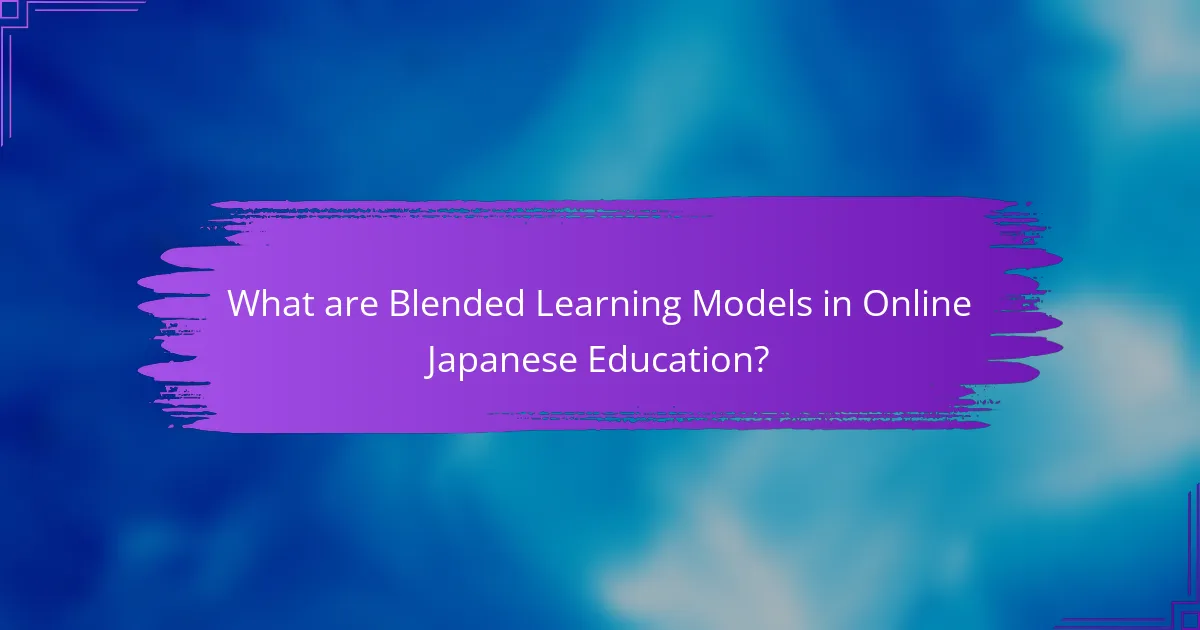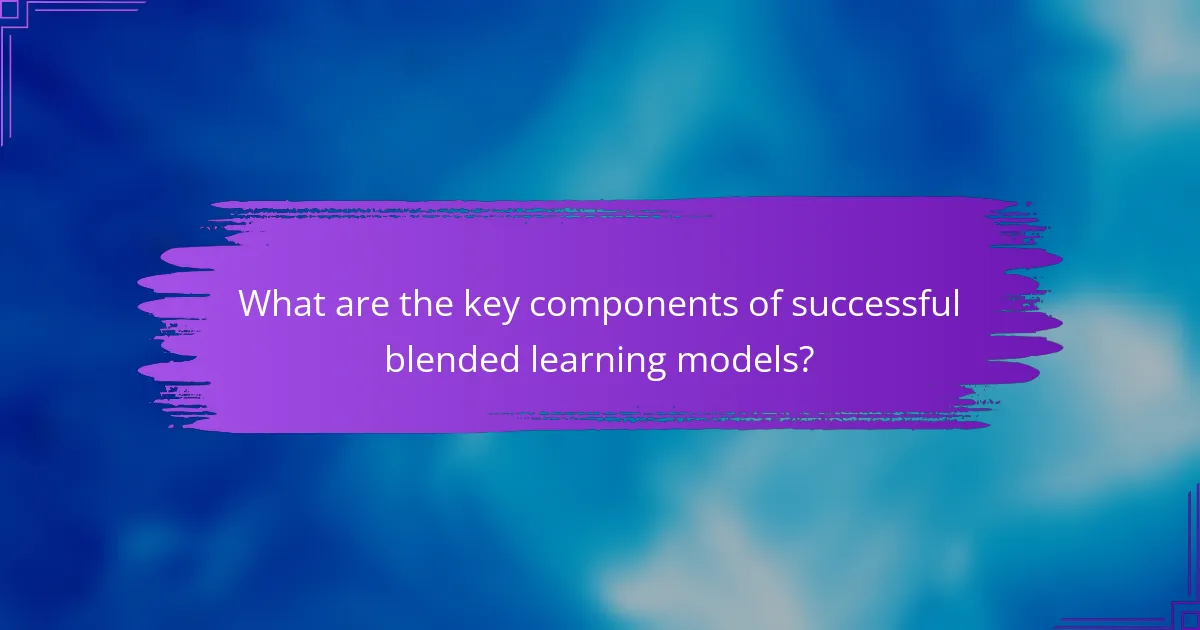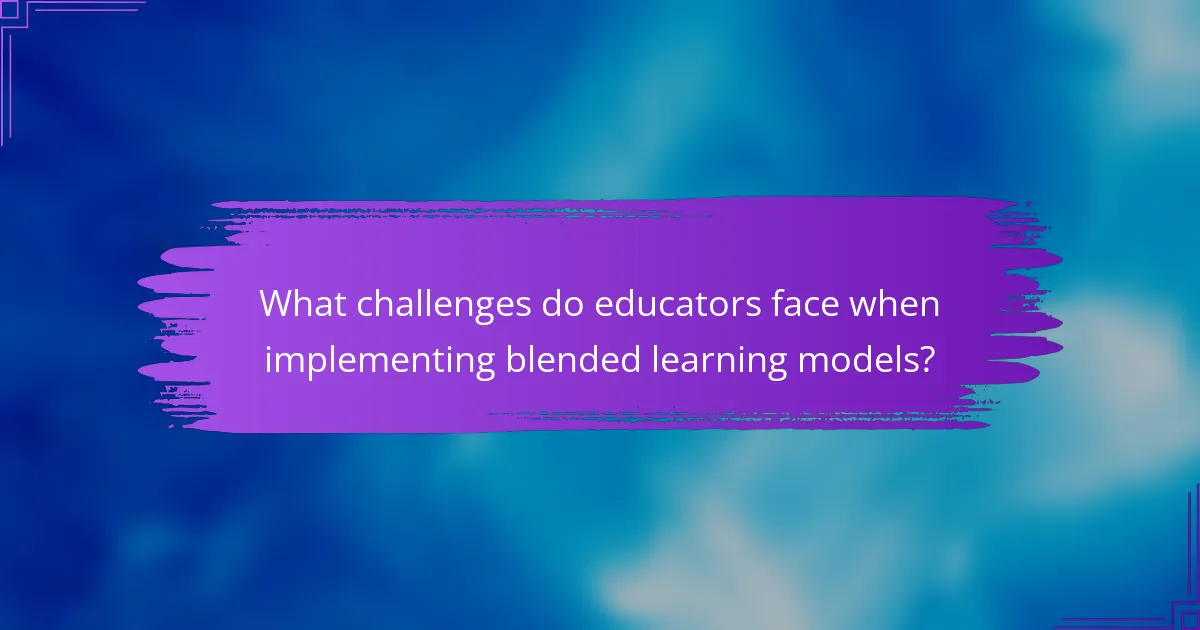
What are Blended Learning Models in Online Japanese Education?
Blended learning models in online Japanese education integrate online resources with face-to-face interaction. These models facilitate a hybrid approach to language learning. Students engage with digital content while also participating in live classes. This combination enhances understanding and retention of the language. Research indicates that blended learning can improve student performance. For example, a study by Graham et al. (2013) found that blended learning environments lead to higher satisfaction and engagement. Blended learning allows for flexibility in scheduling and personalized learning experiences. Overall, these models are effective in teaching Japanese online.
How do blended learning models integrate online resources and face-to-face interaction?
Blended learning models integrate online resources and face-to-face interaction by combining digital content delivery with in-person engagement. This approach allows for flexible learning environments. Students access online materials such as videos, quizzes, and readings at their own pace. In-person sessions are used for discussions, hands-on activities, and personalized feedback. Research shows that this combination enhances student engagement and retention. A study by Graham et al. (2013) indicates that blended learning leads to improved academic performance compared to traditional methods. This integration fosters a more interactive and effective learning experience.
What types of online resources are commonly used in blended learning for Japanese education?
Common online resources used in blended learning for Japanese education include educational platforms, video conferencing tools, and interactive applications. Educational platforms like Moodle and Google Classroom facilitate course management and content delivery. Video conferencing tools such as Zoom and Microsoft Teams enable real-time interaction between teachers and students. Interactive applications, including Duolingo and Quizlet, support language practice and engagement. These resources enhance learning by providing diverse methods of content delivery and interaction. Studies indicate that blended learning improves student engagement and comprehension in language education.
How does face-to-face interaction enhance the learning experience in blended learning?
Face-to-face interaction enhances the learning experience in blended learning by fostering personal connections. These connections promote engagement and motivation among students. Direct communication allows for immediate feedback, which aids comprehension. It also facilitates collaborative learning through group activities. Research shows that students retain information better when they interact in person. According to the Journal of Educational Psychology, face-to-face interaction can increase retention rates by up to 20%. Additionally, it helps build a supportive learning community. This community encourages peer-to-peer learning, which enhances understanding of complex concepts. Overall, face-to-face interaction is vital for effective blended learning environments.
Why is flexibility important in blended learning models for Japanese education?
Flexibility is crucial in blended learning models for Japanese education because it accommodates diverse learning styles and schedules. Japanese students often have varying commitments, including extracurricular activities and part-time jobs. Blended learning allows them to access online resources at their convenience. This adaptability enhances engagement and motivation among students. Research indicates that flexible learning environments can lead to improved academic performance. A study by the Ministry of Education, Culture, Sports, Science and Technology (MEXT) found that students in flexible programs showed higher retention rates. Therefore, flexibility in blended learning is essential for meeting the needs of Japanese learners effectively.
How does flexibility cater to different learning styles in language acquisition?
Flexibility in language acquisition accommodates various learning styles by allowing personalized pacing and methods. It enables learners to choose resources that align with their preferences, such as visual aids or interactive exercises. This adaptability supports auditory, visual, and kinesthetic learners effectively. Research shows that tailored approaches enhance engagement and retention. For instance, a study by Pappas (2015) found that flexible learning environments significantly improve language proficiency. Such environments also encourage self-directed learning, fostering autonomy and motivation. Overall, flexibility directly addresses diverse learning needs in language education.
What role does flexibility play in student engagement and motivation?
Flexibility significantly enhances student engagement and motivation. It allows students to learn at their own pace. This autonomy fosters a sense of ownership over their education. Research indicates that students with flexible learning options show higher motivation levels. A study published in the Journal of Educational Psychology found that flexibility leads to increased academic performance. When students can choose their learning methods, they become more invested in the process. This adaptability also accommodates diverse learning styles, making education more inclusive. Ultimately, flexibility is a key factor in sustaining student interest and commitment in blended learning environments.

What are the key components of successful blended learning models?
Successful blended learning models incorporate several key components. These include a well-structured curriculum that integrates online and face-to-face elements. Effective communication between instructors and students is crucial for engagement. Technology plays a significant role, providing access to resources and facilitating interaction. Flexibility in scheduling allows learners to balance their education with other commitments. Assessment methods should be varied and aligned with learning objectives. Continuous feedback helps to improve the learning experience. Finally, a supportive learning environment fosters motivation and collaboration among students. These components collectively enhance the effectiveness of blended learning models in education.
How do technology tools facilitate blended learning in Japanese education?
Technology tools facilitate blended learning in Japanese education by integrating digital resources with traditional classroom methods. These tools include learning management systems, online collaboration platforms, and multimedia resources. They enable teachers to provide personalized learning experiences. Students can access materials anytime, enhancing flexibility. Virtual classrooms promote real-time interaction between students and instructors. Tools like video conferencing support face-to-face engagement even in remote settings. Research indicates that blended learning improves student engagement and academic performance. A study by the Ministry of Education, Culture, Sports, Science and Technology (MEXT) found that technology-enhanced blended learning leads to higher student satisfaction and better learning outcomes.
What specific tools and platforms are most effective for blended learning?
Learning management systems (LMS) are among the most effective tools for blended learning. Platforms like Moodle and Canvas facilitate course management and content delivery. These systems support both online and face-to-face interactions. Video conferencing tools such as Zoom enhance real-time communication. Interactive platforms like Kahoot! and Quizlet engage students in learning activities. Google Classroom integrates various educational resources seamlessly. Research indicates that blended learning improves student engagement and outcomes. A study by Graham et al. (2013) highlights the effectiveness of these tools in diverse educational settings.
How do these tools support interaction between students and instructors?
These tools enhance interaction between students and instructors by facilitating real-time communication. They provide platforms for video conferencing, enabling face-to-face discussions. Students can ask questions directly during lessons, promoting engagement. Instructors can offer immediate feedback on assignments through integrated messaging systems. Tools also allow for collaborative projects, fostering teamwork among students. Learning management systems track student progress and enable personalized communication. This data-driven approach helps instructors tailor their teaching strategies. Overall, these tools create an interactive learning environment that supports effective education.
What instructional strategies are effective in blended learning environments?
Effective instructional strategies in blended learning environments include personalized learning, collaborative learning, and the use of technology-enhanced resources. Personalized learning tailors education to individual student needs and preferences, leading to improved engagement and outcomes. Collaborative learning encourages students to work together, fostering communication and teamwork skills. The integration of technology, such as learning management systems and multimedia resources, enhances the learning experience and provides diverse content delivery methods. Research shows that these strategies can lead to higher student satisfaction and academic performance in blended learning contexts. For instance, a study by Graham et al. (2013) highlights the positive impact of these strategies on student engagement and learning effectiveness.
How can educators design effective lesson plans that incorporate both online and offline elements?
Educators can design effective lesson plans that incorporate both online and offline elements by integrating technology with traditional teaching methods. This involves selecting appropriate online resources that complement offline activities. For example, using video conferencing tools for real-time discussions enhances face-to-face interaction. Additionally, educators can assign online quizzes to assess understanding while conducting hands-on activities in class.
A blended approach allows for flexibility in learning. Students can access materials online at their own pace and participate in collaborative projects during in-person sessions. Research indicates that blended learning can improve student engagement and achievement. According to a study by Graham et al. (2013) in the “Journal of Asynchronous Learning Networks,” blended learning environments lead to higher satisfaction and learning outcomes.
Incorporating feedback mechanisms is crucial. Educators should solicit student feedback on both online and offline components to refine lesson plans. This iterative process ensures that the lessons remain effective and relevant.
What assessment methods are suitable for evaluating student progress in blended learning?
Formative assessments are suitable for evaluating student progress in blended learning. These assessments occur during the learning process. They provide ongoing feedback to students and instructors. Examples include quizzes, discussions, and peer reviews. Summative assessments also play a role. They evaluate student learning at the end of a unit or course. Standardized tests and final projects are common summative methods. Additionally, self-assessments encourage student reflection on their learning. A combination of these methods offers a comprehensive view of student progress.

What challenges do educators face when implementing blended learning models?
Educators face several challenges when implementing blended learning models. One major challenge is the integration of technology into the classroom. Many educators may lack the necessary skills or training to effectively use digital tools. Additionally, there is often a disparity in access to technology among students. This can hinder equal participation in blended learning environments.
Another challenge is balancing online and face-to-face interactions. Educators must find the right mix to maintain student engagement. Moreover, time management becomes critical as educators juggle lesson planning for both formats.
Assessment methods also pose difficulties. Traditional assessments may not effectively measure student learning in a blended model. Lastly, educators may encounter resistance from students or parents who prefer conventional teaching methods. These challenges can significantly impact the successful implementation of blended learning models.
How can educators address technological barriers in blended learning?
Educators can address technological barriers in blended learning by providing comprehensive training on digital tools. This training should focus on both educators and students. Ensuring access to reliable internet is crucial for effective blended learning. Schools can partner with local organizations to improve connectivity. Offering technical support helps resolve issues promptly. Regular feedback from students can identify persistent barriers. Utilizing user-friendly platforms can enhance engagement and accessibility. Research shows that effective training increases technology adoption rates among educators.
What solutions exist for students who lack access to technology?
Solutions for students who lack access to technology include community internet programs and local libraries. Many communities offer free Wi-Fi access in public spaces. Libraries often provide computers and internet access for students. Schools can implement loaner programs for devices. Some organizations offer grants to provide technology to underserved students. Additionally, mobile hotspots can be distributed to families in need. Partnerships with tech companies can facilitate access to affordable devices. These solutions help bridge the digital divide for students.
How can educators ensure that all students are engaged in a blended learning environment?
Educators can ensure that all students are engaged in a blended learning environment by utilizing diverse instructional strategies. These strategies include interactive online activities, collaborative projects, and personalized learning paths. Incorporating technology such as learning management systems enhances accessibility and engagement. Regular feedback and assessments help educators identify student needs and adapt accordingly. Providing opportunities for face-to-face interaction fosters a sense of community. Research shows that blended learning can improve student motivation and performance. A study by Graham et al. (2013) indicates that effective blended learning environments lead to higher engagement levels. Thus, a combination of varied teaching methods and continuous assessment is crucial for student engagement.
What best practices can enhance the effectiveness of blended learning in Japanese education?
Effective blended learning in Japanese education can be enhanced by integrating technology with traditional teaching methods. Utilizing interactive digital platforms fosters student engagement. Incorporating regular feedback mechanisms helps track student progress. Providing flexible learning schedules accommodates diverse student needs. Training teachers in blended learning techniques ensures effective implementation. Establishing a collaborative learning environment encourages peer interaction. Utilizing culturally relevant content enhances relatability and interest. Research shows that these practices lead to improved student outcomes and satisfaction.
How can educators foster a collaborative learning environment in blended settings?
Educators can foster a collaborative learning environment in blended settings by integrating technology with face-to-face interactions. They should utilize online platforms that facilitate group discussions and project collaboration. Tools like discussion forums and shared documents encourage student participation. Regularly scheduled in-person meetings can strengthen team dynamics and build rapport. Educators must create clear guidelines for collaboration to ensure accountability among students. Providing diverse group activities can cater to different learning styles and preferences. Research shows that collaborative learning enhances engagement and improves academic outcomes. A study by Johnson & Johnson (2014) indicates that cooperative learning strategies lead to higher achievement and greater retention of knowledge.
What tips can help students maximize their learning experience in blended models?
Students can maximize their learning experience in blended models by actively engaging with both online and in-person components. They should create a structured study schedule that allocates time for both types of learning. Utilizing online resources effectively enhances understanding and retention. Participating in face-to-face discussions fosters collaboration and deeper insights. Seeking feedback from instructors can clarify doubts and guide improvement. Setting specific learning goals helps maintain focus and motivation. Utilizing technology tools for organization can streamline the learning process. According to research by the U.S. Department of Education, blended learning can lead to improved student outcomes when implemented with these strategies.
Blended learning models in online Japanese education combine online resources with face-to-face interaction, creating a hybrid approach to language learning. These models enhance student engagement and retention through flexible scheduling and personalized learning experiences. Key components include effective technology integration, diverse instructional strategies, and ongoing assessments that cater to different learning styles. Challenges such as technological barriers and the need for effective communication are addressed through best practices that foster collaboration and support. Overall, blended learning models prove to be effective in improving student performance and satisfaction in Japanese language education.